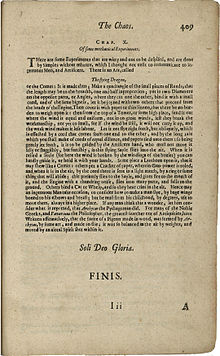Giambattista della Porta
Giambattista della Porta or Giovan (ni) Battista della Porta , also Ioannes or Johann Baptista Porta (* between October 3 and November 15, 1535 in Vico Equense ; † February 4, 1615 in Naples ) was a Neapolitan physician, polymath and playwright .
Life
G. della Porta came from a noble family, was self-taught, but was also taught by the royal scholar Giovanni Antonio Pisano and the Paduan translator Domenico Pizzimenti.
In 1580 he founded a study center and discussion forum for researching natural secrets, the Accademia dei Segreti .
Due to his methodology and relative neutrality, he is considered one of the first natural scientists in the modern sense. From 1558 to 1589 he published the Magia naturalis in 20 volumes (in which he handed down one of the few existing witch's ointment recipes ), which brought him first fame. He claimed (incorrectly) that he was only 15 years old when it was written. He mentions a water drum blower for the first time to generate a continuous jet of air for a forge in Nettuno, south of Rome. In volume 20 he describes the construction of a fettered kite .
A society for the study of nature he founded in Naples in 1560, the Academia Secretorum Naturae , had to be dissolved by order of the Pope. His fundamental work on cryptology entitled De furtivis literarum notis (On the Hidden Meaning of Letters), published in 1563, made him famous for good. Around 1570 he further developed the camera obscura , an early forerunner of the camera .
The Pomarium (about fruit growing) and Olivetum (about olive growing), published in 1583 and 1584 respectively, were incorporated into his more comprehensive work on agriculture, Villae of 1592. Before that, however, in 1586, his second major work appeared, a medical work entitled De humana physiognomia , 1588 followed by a work on the physiognomy of plants, "Phytognomica". Here he tried to draw conclusions about their effect from the appearance and life of the plants. He explained that herbs with yellow juice could cure jaundice, those with rough surfaces could cure skin diseases. Because of his preoccupation with magic and physiognomy, he had to answer to the Inquisition in 1592 , but the proceedings had no consequences for him. In the following years he withdrew from the sciences as a precaution and turned to dramatic literature. His comedy La Trappolaria , one of many successful dramatic works, was published in Bergamo in 1596 .
Works

- Magiae naturalis sive de miraculis rerum naturalium , 1558 (Alchemy) Digitized from the Naples 1589 edition
- De furtivis literarum notis , 1563 (cryptology) digitized
- De humana physiognomonia , 1586 (medicine) digitized
- Phytognomonica , 1588, (botany) online resource on Real Jardín Botánico, Madrid
- La Penelope , 1591 (tragedy)
- Villae , 1592 (agriculture) digitized
- La Trappolaria , 1596 (literature) online resource (Italian)
- Il Georgio , 1611 (tragedy)
- L'Ulisse , 1614 (tragedy)
- De telescopio , 1962 (posthumous)
literature
- Raffaella Zaccaria: DELLA PORTA, Giovambattista. In: Massimiliano Pavan (ed.): Dizionario Biografico degli Italiani (DBI). Volume 37: Della Fratta – Della Volpaia. Istituto della Enciclopedia Italiana, Rome 1989.
- Hilke Schneider: Physiognomic facial types in Giambattista Della Porta's work 'De Humana Physiognomia' analyzed with modern computer-aided cephalometric methods 2003 urn : nbn: de: bvb: 91-diss2003031903473 .
- Laura Balbiani: La magia naturalis di Giovan Battista della Porta: lingua, cultura e scienza in Europe all'inizio dell'età moderna (= IRIS, research on European culture. Volume 17. - Zugl .: Milano, Univ., Diss., 1999). Lang, Bern / Berlin / Bruxelles / Frankfurt a. M. / New York / Oxford / Vienna 2001, ISBN 3-906767-22-1 .
- Laura Balbiani: Della Porta, Giovan Battista. In: Gudrun Gersmann, Katrin Moeller, Jürgen-Michael Schmidt (eds.): Lexicon for the history of witch persecution. historicum.net.Retrieved September 19, 2008.
- Arianna Borrelli : Giovan Battista Della Porta's Neapolitan Magic & His Humanistic Meteorology. In: Variantology 5. Neapolitain Affairs. Verlag der Buchhandlung Walther König, Cologne 2011, ISBN 978-3-86560-887-1 .
- Barbara I. Tshisuaka: Porta, Giovanni Battista della. In: Werner E. Gerabek , Bernhard D. Haage, Gundolf Keil , Wolfgang Wegner (eds.): Enzyklopädie Medizingeschichte. De Gruyter, Berlin / New York 2005, ISBN 3-11-015714-4 , p. 1176.
- Siegfried Zielinski : Magic & Experiment. The Porta Chapter. In: Siegfried Zielinski: Archeology of the media. At the depth of technical hearing and seeing. Rowohlt, Reinbek bei Hamburg 2002, ISBN 3-499-55649-9 , pp. 76-124.
Web links
- Publications by and about Giambattista della Porta in VD 17 .
- Detailed biography. ( Memento from May 16, 2008 in the Internet Archive )
- John J. O'Connor, Edmund F. Robertson : Giambattista della Porta. In: MacTutor History of Mathematics archive .
Individual evidence
- ↑ According to Zaccaria in the DBI, both place and year of birth are uncertain; around 1535 can be derived from his curriculum vitae, which Della Porta presented for admission to the Accademia dei Lincei.
- ↑ John Baptista Porta: Natural magick . T. Young and S. Speed, London 1658, p. 409 ( Draco volans - Latin: Magiae naturalis . Naples 1589. First edition: Naples 1558, translated into English).
- ↑ A. Arber: Herbals, their origin and evolution. London 1912, p. 208.
| personal data | |
|---|---|
| SURNAME | Della Porta, Giambattista |
| ALTERNATIVE NAMES | Della Porta, Giovanni Battista; Della Porta, Giovan Battista; Porta, Giovanni Battista dalla; Porta, Giovanni Battista della; Porta, Joannes Baptista |
| BRIEF DESCRIPTION | Neapolitan physician, polymath and playwright |
| DATE OF BIRTH | between October 3, 1535 and November 15, 1535 |
| PLACE OF BIRTH | Vico Equense |
| DATE OF DEATH | February 4, 1615 |
| Place of death | Naples |

